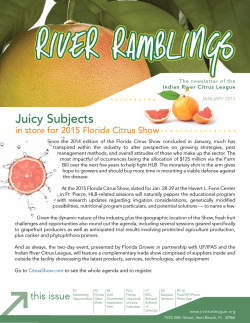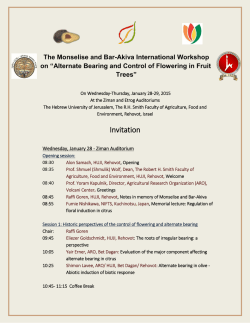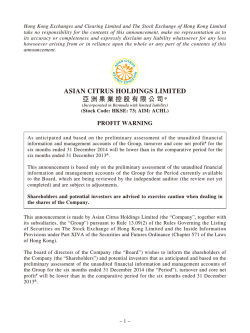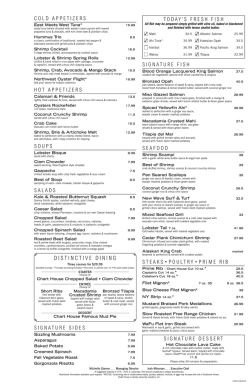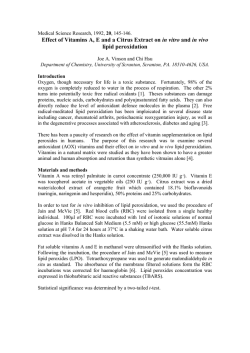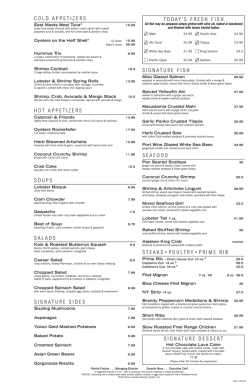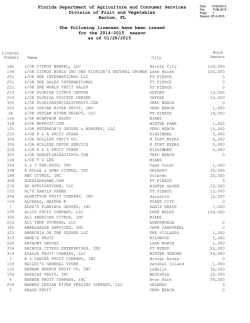
Occurrence of `Candidatus Phytoplasma asteris` in citrus showing
Crop Protection 62 (2014) 144e151 Contents lists available at ScienceDirect Crop Protection journal homepage: www.elsevier.com/locate/cropro Occurrence of ‘Candidatus Phytoplasma asteris’ in citrus showing Huanglongbing symptoms in Mexico Alda Alejandra Arratia-Castro, María Elena Santos-Cervantes, Ernesto Fernández-Herrera 1, Jesús Alicia Chávez-Medina, Gabriela Lizbeth Flores-Zamora, Erika Camacho-Beltrán, Jesús Méndez-Lozano, Norma Elena Leyva-López* Instituto Politécnico Nacional, CIIDIR, Unidad Sinaloa, Departamento de Biotecnología Agrícola, Blvd. Juan de Dios Bátiz Paredes No. 250, San Joachín, Guasave, Sinaloa, Mexico C.P. 81101 a r t i c l e i n f o a b s t r a c t Article history: Received 14 December 2013 Received in revised form 22 April 2014 Accepted 23 April 2014 Huanglongbing (HLB), one of the most devastating citrus diseases in the world, was detected in Mexico in 2009. Currently, HLB is associated with the bacteria Candidatus Liberibacter spp., although several phytoplasmas have been found from trees showing HLB-like symptoms in Brazil and China. The aim of this study was thus to determine if, in addition to ‘Ca. L. asiaticus’ (CLas), phytoplasma species are also associated with HLB-like symptoms in citrus groves of Mexico. Citrus plants exhibiting symptoms such as diffuse chlorosis, blotchy mottle and vein yellowing were collected in the Mexican States of Nayarit, Colima and Sinaloa between August 2011 and September 2012. Samples were then evaluated for phytoplasmas and CLas by PCR, using primers that respectively target the genes for the 16S ribosomal RNA and 50S ribosomal protein of the b operon (rplA-rplJ). Out of 86 HLB-symptomatic citrus plants, 54 were positive for CLas, 20 were positive for phytoplasmas, 7 were found in mixed infections with both pathogens and 19 samples were negative for CLas and phytoplasmas. Actual and virtual RFLP analyses of the 16S rDNA sequences enabled us to classify two HLB phytoplasma strains as members of the aster yellows group (16SrI) ‘Candidatus Phytoplasma asteris’, which was confirmed by phylogenetic analysis. The HLB phytoplasma strain identified from Nayarit (HLBpc-Nay-IB) belongs to subgroup B (16SrI-B), and the strains identified from Colima (HLBpc-Col-IS) and Sinaloa (HLBpc-Sin-IS) belong to subgroup S (16SrI-S). The partial ‘Ca. L. asiaticus’ rplA-rplJ gene sequences were 100% identical to the ‘Ca. L. asiaticus’ strains isolated from several countries affected by HLB. These results confirm the association of ‘Candidatus Phytoplasma asteris’ with HLB-like symptoms in citrus groves in Mexico. Nonetheless, further studies are required to fully describe the ‘Ca. L. asiaticus’ and ‘Ca. P. asteris’ interactions in citrus, which will greatly assist the design of efficient management strategies. Ó 2014 Elsevier Ltd. All rights reserved. Keywords: Phytoplasmas ‘Candidatus Phytoplasma asteris’ Huanglongbing PCR Virtual RFLP analyses Phylogenetic tree 1. Introduction Citrus trees are one of the most important fruit trees cultivated in Mexico. The national production in 2012 was 6.68 million metric tons, with a value of US$965 million (SAGARPA, 2012). In 2009, Huanglongbing (HLB) disease, one of the most destructive citrus diseases in the world, was first detected in the Mexican States of Yucatan (in citrus residential trees) and * Corresponding author. Tel.: þ52 6878729626; fax: þ52 6878729625. E-mail addresses: [email protected], [email protected] (N.E. Leyva-López). 1 Present address: Universidad de Sonora, Departamento de Agricultura y Ganadería, Carretera Bahía de Kino, Km. 21, Apartado postal 305. Hermosillo, Sonora, Mexico. http://dx.doi.org/10.1016/j.cropro.2014.04.020 0261-2194/Ó 2014 Elsevier Ltd. All rights reserved. Nayarit (in commercial orchards). Currently, HLB is present in 15 of Mexico’s 23 citrus producing States (SAGARPA, 2013). HLB has been associated with ‘Candidatus Liberibacter spp.’, a group of gram-negative, phloem-limited a-proteobacteria given provisional Candidatus status (Jagoueix et al., 1994). Based on their 16S rDNA sequences, three species of ‘Ca. Liberibacter’ have been identified from trees with HLB disease: ‘Ca. L. asiaticus’ and ‘Ca. L. americanus’ (both transmitted by the Asian citrus psyllid Diaphorina citri Kuwayama), and ‘Ca. L. africanus’, transmitted by the psyllid Trioza erytreae (Bové, 2006; Gottwald, 2010). Intriguingly, the examination of other possible HLB incidents around the world has led to the identification of an additional putative etiological agent. In Sao Paulo State (SPS), Brazil, the disease was only associated with ‘Ca. L. asiaticus’ and ‘Ca. L. americanus’ from 2004 until 2007. A.A. Arratia-Castro et al. / Crop Protection 62 (2014) 144e151 However, HLB-affected orange trees with characteristic blotchy mottled leaves and symptomatic fruits that were negative for the presence of ‘Ca. Liberibacter spp.’ were identified in 2007, and a new phytoplasma disease agent was identified from these symptomatic HLB samples. This phytoplasma is closely related to the pigeon pea witches’-broom phytoplasma, based on its 16S rDNA sequence (Teixeira et al., 2008). Furthermore, the 16SrI group ‘Candidatus Phytoplasma asteris’ has been reported in several leaf citrus samples (mandarin, sweet orange, and pomelo) with typical HLB yellowing/mottling symptoms from southern China (Chen et al., 2009). Recently a phytoplasma of the subgroup 16SrIIA* was characterized in a Huanglongbing-infected grapefruit (Citrus paradisi) orchard, in Guangxi Province, China (Lou et al., 2014). Phytoplasmas are plant pathogens that primarily inhabit the phloem sieve-tube, and which are transmitted and naturally disseminated by insect vectors from the Cicadelloidea (leafhoppers) and Fulgoroidea (planthoppers) families (Gasparich, 2010). These plant pathogens are associated with more than 700 diseases in several hundred of plant species, and their broad plant host range depends on the plant feeding range of their insect vectors (Lee et al., 1998b; Namba, 2011). The phytoplasmas that cause many fruit tree diseases are primarily transmitted by insects and grafting (Heinrich et al., 2001). They are obligate symbionts of plants and insects, and in most cases require both the plant and insect hosts for their dispersal in nature. The titer of phytoplasma cells in the phloem of infected plants varies by season and plant species, and it is often very low in woody hosts, presenting a major obstacle to the diagnosis of these phytopathogens (Marzachi, 2004). The diagnosis of Huanglongbing disease is based on symptoms such as foliar blotchy mottle (Bové, 2006), as well as the use of DNA hybridization 145 (Villechanoux et al., 1992) and the polymerase chain reaction (PCR) (Jagoueix et al., 1996; Hocquellet et al., 1999; Teixeira et al., 2005; Li et al., 2006; Lin et al., 2010). These molecular techniques make it possible to accurately and rapidly diagnose Ca. Liberibacter spp., whereas the differentiation and classification of several hundred phytoplasma strains necessitates distinct 16S rRNA gene restriction fragment length polymorphism (RFLP) patterns resolved by actual and/or virtual analysis (Lee et al., 1998a; Wei et al., 2008). Given this background, the main objective of the present study was to determine if, in addition to ‘Ca. L. asiaticus’, phytoplasma species are associated with similar HLB leaf symptoms in Mexico. 2. Material and methods 2.1. Plant material and phytoplasma reference strain Leaf samples displaying characteristic blotchy mottle symptoms (Fig. 1) were collected from citrus orchards in the Mexican States of Nayarit, Colima and Sinaloa between August 2011 and September 2012. Citrus plant species included Mexican lime (Citrus aurantifolia, Christm., Swingle), Persian lime (Citrus latifolia, Tanaka), and Valencia sweet orange (Citrus sinensis, (L.) Osbeck). The samples were shipped to the Molecular Biology Research Laboratory at the CIIDIR-IPN, Sinaloa Unit. Upon arrival, samples were stored at 4 C and processed within 48e72 h. Leaf midribs were lyophilized (lyophilizer, Labconco, Kansas City, MO). Total genomic DNA from a Mexican phytoplasma strain representative of group 16SrI, subgroup 16SrI-S, Potato purple top BC15 (PPT-BC15-IS, GenBank accession number FJ914638) was used as the phytoplasma reference control (Santos-Cervantes et al., 2010). Fig. 1. Foliar HLB-like symptoms in Mexican lime samples PCR positive for ‘Candidatus Liberibacter asiaticus’ (CLas) and/or ‘Candidatus Phytoplasma spp.’ (CP). Leaf in A showing diffuse chlorosis positive for CLas; Leaves in B, D and E showing different pattern of blotchy mottle positive for CLas, CLas/CP and CLas, respectively; leaf in C showing vein yellowing positive only for CP. Leaf in F showing no symptoms and negative for CLas and CP (healthy control leaf). The figure was created using ScientiFig software (Aigouy and Mirouse, 2013). 146 A.A. Arratia-Castro et al. / Crop Protection 62 (2014) 144e151 2.2. DNA extraction 2.5. Cloning of PCR products and DNA sequencing The collected citrus samples were next examined by molecular analyses. Total nucleic acids were extracted from lyophilized leaf midribs, using a previously described CTAB protocol (Zhang et al., 1998) with minor modifications. Twenty milligrams of lyophilized leaf midribs were transferred to a 1.5-mL tube and ground in 800 mL of preheated (60 C) CTAB extraction buffer (3% CTAB, 1.4 M NaCl, 20 mM EDTA, 100 mM Tris-HCl, pH 8.0, 0.2% mercapto-ethanol), followed by incubation at 60 C for 30 min. Samples were extracted with chloroform-isoamyl alcohol (24:1). Four microliters of RNase A (100 mg/mL) was added and incubated at 37 C for 10 min. The aqueous DNA layer was precipitated with 600 mL of cold isopropanol. DNA pellets were then washed with 70% ethanol, dried, and suspended in 30 mL of sterile twice-distilled water. The quantity and purity of DNA samples were assessed measuring OD 260 nm and OD 260 nm/280 nm, respectively, using the NanoDrop ND1000 UVeVis Spectrophotometer (NanoDrop Technologies, Wilmington, DE, USA). DNA concentration was adjusted to 20 ng/mL and kept at 20 C for further use. Both Phytoplasma and ‘Ca. L. asiaticus’ PCR products (comprising representative samples from different States) were purified using Wizard SV Gel and PCR Clean-Up System (Promega Corporation, USA). Purified fragments were ligated into a pGEM-T Easy vector (Promega Corporation, USA) and transformed into JM109 competent cells following the manufacturer’s instructions. Plasmid DNA from recombinant culture colonies was isolated and purified using the Wizard Plus SV Minipreps DNA Purification System (Promega Corporation, USA). Both strands from two different clones of each organism isolate were completely sequenced twice in an ABI PRISM 377 sequencer, using the Dye cycle sequencing kit (Applied Biosystems, Foster City, CA). The phytoplasmas and ‘Ca. L. asiaticus’ sequences were then deposited in the NCBI GenBank. 2.3. Phytoplasma and ‘Ca. Liberibacter asiaticus’ detection by PCR Phytoplasmas were detected using two “universal” phytoplasma nested primer pairs (R16mF2/R16mR1 in the first round and R16F2n/R16R2 for the nested PCR reaction) that amplify an approximately 1250 bp portion of the 16S rDNA (Gundersen and Lee, 1996), as previously described (Santos-Cervantes et al., 2008). A 703 bp fragment was PCR amplified from the ‘Ca. L. asiaticus’ 50S ribosomal protein gene of the b operon (rplA-rplJ) with the following program: 35 cycles at 94 C for 30 s (one cycle of initial denaturalization at 94 C for 2 min), with annealing at 62 C for 30 s and extension at 72 C for 1 min, and a final extension at 72 C for 10 min (Hocquellet et al., 1999). PCR amplification of the two pathogens was conducted in an automatic thermocycler (C1000 Thermal Cycler, BioRad, USA), in a final volume of 25 mL containing: one unit of Taq DNA polymerase (Invitrogen Life Technologies, Brazil); 200 mM of each dNTP; 0.4 pmol/mL of each primer; and 100 ng of total DNA. Sample DNA was replaced by deionized sterile water for a PCR negative control. PCR products were analyzed by electrophoresis in a 1% agarose gel and visualized by ethidium bromide staining (2 mg/mL) under a UV transilluminator. 2.4. Actual RFLP analysis of detected phytoplasmas R16F2n/R16R2 PCR phytoplasma fragments from representative citrus samples were digested with AluI, HhaI, MseI, HaeIII, RsaI, and TaqI restriction endonucleases according to the manufacturer’s instructions (Invitrogen Life Technologies, USA). The digestion products were then fractionated by gel-based capillary electrophoresis, using a high-resolution gel cartridge kit on a QIAxcel system (Qiagen, Valencia, CA). A 72-1353 bp fX174DNA-HaeIII digest Marker (New England Biolabs, Beverley, MA) was included in QIAxcel runs and the size of the products was determined using the QIAxcel Screen Gel software. The QX DNA Alignment Marker, consisting of 15-bp and 3000-bp bands, was automatically injected by the QIAxcel system onto the cartridge along with each sample, allowing the software to align the lanes. The OL500 method was used to analyze the digestion products (Qiagen, Valencia, CA). The obtained RFLP patterns were compared to electrophoretic patterns of known phytoplasmas previously described by Lee et al. (1998a), as well as to a phytoplasma reference strain (Santos-Cervantes et al., 2010). 2.6. DNA sequence analysis and in silico enzyme digestions The phytoplasma R16F2n/R2 sequences and the ‘Ca. L. asiaticus’ rplA-rplJ sequences were compared to the references in the GenBank database, using the BLASTn program (Altschul et al., 1990). Virtual RFLP analysis was performed on the R16F2n/R2 16Sr DNA sequences from phytoplasma isolates (this study), as well as two phytoplasmas affiliated with the 16SrI-B (Citrus HLB-IB and AY-IB, GenBank accession numbers EU544303 and AY180943, respectively) and 16SrI-S (PPT-BC15-IS, GenBank accession number FJ914638) subgroups, using the virtual gel plotting program pDRAW32 (AcaClone). Each aligned 16S rDNA sequence was digested in silico with 17 restriction enzymes (AluI, BamHI, BfaI, BstUI, DraI, EcoRI, HaeIII, HhaI, HinfI, HpaI, HpaII, KpnI, Sau3AI, MseI, RsaI, SspI, and TaqI) that have been routinely used for phytoplasma 16S rDNA RFLP analysis (Lee et al., 1998a). The virtual RFLP patterns were compared and a similarity coefficient (F) was calculated for each pair of phytoplasma strains using a Perl program developed by Wei et al. (2008). 2.7. Phylogenetic analysis The Clustal W method (Thompson et al., 1994) was used to align the R16F2n/R2 16S rDNA sequences from HLB phytoplasma isolates, along with 19 phytoplasmas representing distinct phytoplasma groups or subgroups, and Acholeplasma palmae. The rplA-rplJ sequences from ‘Ca. L. asiaticus’ were aligned with other ‘Ca. L. asiaticus’ strains from GenBank. Phylogenetic trees were constructed with the Neighbor-Joining method, using the MEGA program v. 5.2.2 (Tamura et al., 2011). Bootstrapping with 1000 replicates was performed to estimate the branch stability and support. 3. Results 3.1. Phytoplasma and ‘Ca. L. asiaticus’ detection by PCR Phytoplasmas were detected by nested PCR in symptomatic citrus infected leaves in all three states where samples were collected, in single as well as in mixed infections with ‘Ca. L. asiaticus’. The results for PCR analysis of both pathogens in citrus are summarized in Table 1. Out of 86 HLB-symptomatic citrus plants, 54 were positive for CLas, 20 were positive for phytoplasmas, 7 were found in mixed infections with both pathogens and 19 samples were negative for CLas and phytoplasmas. 3.2. Actual RFLP analysis of detected phytoplasmas To identify HLB phytoplasma isolates detected in citrus samples, two R16F2n/R16R2 amplicons from each State were digested with A.A. Arratia-Castro et al. / Crop Protection 62 (2014) 144e151 Table 1 Detections in citrus samples with HLB symptoms of three Mexican States using polymerase chain reaction (PCR). States Cultivars No. of PCR resultb samplesa CLas þ CP þ CLas þ CLas þ CLas L CLas L CP þ CP L CP þ CP L Nayarit Mexican lime 12 Persian lime 8 Colima Mexican lime 33 Sinaloa Mexican lime 23 10 Valencia sweet orange Total 86 % 100 4 8 30 12 0 54 62.8 6 1 6 3 4 0 1 5 1 0 20 7 23.3 8.1 4 7 25 11 0 47 54.7 6 0 1 2 4 2 0 2 9 6 13 15.1 19 22.1 a Each sample was collected from individual tree. ‘Candidatus Liberibacter asiaticus’ (CLas) was detected by conventional PCR using primers A2/J5 and ‘Candidatus Phytoplasma spp.’ (CP) was detected by nested PCR with primer pairs R16mF2-R16mR1/R16F2n-R16R2. b AluI, HaeIII, HhaI, MseI, RsaI and TaqI (Fig. 2). The collective RFLP patterns indicate that three HLB phytoplasma isolates from citrus belong to the aster yellows group (16SrI) ‘Ca. P. asteris’, according to the phytoplasma classification scheme (Lee et al., 1998a). The HaeIII and TaqI profiles of HLB phytoplasma isolates from Nayarit were identical to the phytoplasma subgroup 16SrI-B, according to the classification of Lee et al. (1998a); the HLB phytoplasma isolates from Colima and Sinaloa were identical to the phytoplasma reference strain PPT-BC15-IS (GenBank Accession Number FJ914638), which belongs to subgroup 16SrI-S (Santos-Cervantes et al., 2010). These results suggest that our approach is well-suited for the differentiation and preliminary classification of HLB phytoplasma isolates, as compared to previous reports (Lee et al., 1998a; SantosCervantes et al., 2010). Furthermore, these data provide strong evidence that citrus are infected by two distinct HLB phytoplasma strains (16SrI-B and 16SrI-S), both of which belong to the aster yellows group (16SrI) ‘Ca. P. asteris’. 147 3.3. Nucleotide sequence analysis and in silico enzyme digestions The R16F2n/R2 sequence of the HLB phytoplasma isolate from Nayarit (GenBank accession number AB858472) shared the highest identity (99%) with Rush yellows phytoplasma (RhY strain; GenBank accession number AB738740; Max Score: 2283) and Chinese Huanglongbing disease-associated phytoplasma (Citrus HLB-IB strain; GenBank accession number EU544303; Max Score: 2278). A 1246-bp sequence in two phytoplasma strains revealed three (RhY strain) and four (Chinese citrus HLB-IB strain) mismatches in comparison to an HLB phytoplasma isolate from Nayarit. The R16F2n/R2 sequences of the HLB phytoplasma isolates from Colima and Sinaloa (GenBank accession numbers AB858473 and AB858474, respectively) shared the highest identity (99%) with Mexican potato purple top phytoplasma (PPT-BC15-IS strain; GenBank accession number FJ914638; Max Scores: 2285 and 2290, respectively) and the Chinese citrus HLB-IB strain (Max Scores: 2252 and 2263, respectively). In comparison to the PPT-BC15-IS strain, three mismatches were found in HLB phytoplasma isolates from Colima, whereas two were found in isolates from Sinaloa. As for the Chinese citrus HLB-IB strain, nine mismatches were found in HLB phytoplasma isolates from Colima, whereas seven were found in isolates from Sinaloa. The HLB phytoplasma isolates detected in citrus samples were classified as strains of ‘Ca. P. asteris’, and were designated as HLBpcNay-IB, HLBpc-Col-IS, and HLBpc-Sin-IS (Table 2). The rplA-rplJ sequences of ‘Ca. L. asiaticus’ isolates from Nayarit, Colima and Sinaloa (GenBank accession numbers AB859774, AB859772, AB859773, respectively) showed 100% sequence identity with ‘Ca. L. asiaticus’ isolates identified from China, USA, Indonesia, Japan, India and Ethiopia (GenBank accession numbers CP004005, CP001677, AB490691, AB490292, GU074017, and GQ890156, respectively). The isolates of Candidatus Liberibacter detected in citrus samples were classified as strains of ‘Ca. L. asiaticus’, and were designated as HLBlas-Nay, HLBlas-Col, and HLBlas-Sin. Fig. 2. QIAxcel graphical display of RFLP profiles of R16F2n/R16R2 amplicons from HLB phytoplasma isolates and a phytoplasma reference strain (PPT-BC15-IS). Six restriction enzymes were used for the different digestions: AluI, HaeIII, HhaI, MseI, RsaI, and TaqI. MW, fX174DNA-HaeIII digestion (New England Biolabs, Beverley, MA). 148 A.A. Arratia-Castro et al. / Crop Protection 62 (2014) 144e151 Table 2 Similarity coefficients derived from analysis of virtual restriction fragment length polymorphism (RFLP) patterns of 16S rRNA genes from phytoplasma strains in the aster yellows (16SrI) group and three citrus-infecting phytoplasma strains in Mexico.a Serial no. Strain Subgroup (GenBank accession) 1 2 3 4 5 6 7 8 9 10 11 1 2 3 4 5 6 7 8 9 10 11 AY-WB AY-IB CPh PaWB BBS3 ACLR-AY PPT-BC15-IS Citrus HLB-IB HLB-Nay-IB HLB-Col-IS HLB-Sin-IS 16SrI-A (AY389828) 16SrI-B (AY180943) 16SrI-C (AF222065) 16SrI-D (AY265206) 16SrI-E (AY265213) 16SrI-F (AY265211) 16SrI-S (FJ914638) 16SrI (EU544303) 16SrI-B (AB858472) 16SrI-S (AB858473) 16SrI-S (AB858474) 1 0.92 0.91 0.91 0.91 0.86 0.88 0.92 0.92 0.87 0.88 1.00 0.93 0.97 0.93 0.88 0.96 1.00 1.00 0.94 0.96 1.00 0.9 0.92 0.87 0.9 0.93 0.93 0.9 0.9 1.00 0.9 0.85 0.93 0.97 0.97 0.91 0.93 1.00 0.87 0.9 0.93 0.93 0.88 0.9 1.00 0.84 0.88 0.88 0.82 0.84 1.00 0.96 0.96 0.98 1.00 1.00 1.00 0.94 0.96 1.00 0.94 0.96 1.00 0.98 1.00 a The sequences obtained in our study are shown in bold. Virtual RFLP analysis of 16S rRNA sequences was used to assign HLB phytoplasma strains to subgroups (Wei et al., 2008). The results reveal that the HLBpc-Nay-IB strain detected in Mexican lime has a pattern type identical to the reference pattern of the 16Sr group I ‘Ca. P. asteris’, subgroup B (AY-IB phytoplasma strain, GenBank accession number AY180943). The similarity coefficient of 1.00 indicates that HLBpc-Nay-IB belongs to the 16SrI-B subgroup (Fig. 3, Table 2). On the other hand, the HLBpc-Sin-IS strain detected in Valencia sweet orange has a pattern type identical to the PPTBC15-IS phytoplasma strain belonging to subgroup S from ‘Ca. P. asteris’. Its similarity coefficient of 1.00 therefore assigns HLBpcSin-IS to the 16SrI-S subgroup (Fig. 3; Table 2). The HLBpc-Col-IS strain detected in Mexican lime has a pattern type similar to the PPT-BC15-IS phytoplasma strain, whereas the MseI virtual digestion pattern was different (similarity coefficient ¼ 0.98). This strain thus belongs to the 16SrI-S subgroup, following the criteria of Wei et al. (2008). 3.4. Phylogenetic analysis The R16F2n/R2 sequences of three phytoplasma strains associated with HLB were compared with 19 phytoplasma strains representing distinct phytoplasma groups or subgroups, in addition to A. palmae, yielding the consensus tree illustrated in Fig. 4. This tree indicates that all phytoplasma strains belonging to ‘Ca. P. asteris’ congregate together to form a discrete clade including HLB phytoplasma strains isolated from citrus samples (HLBpc-Nay-IB, HLBpcCol-IS, and HLBpc-Sin-IS). The HLBpc-Col-IS and HLBpc-Sin-IS strains clustered in the same phylogenetic branch as the PPTBC15-IS phytoplasma strain (confirmed by virtual RFLP analysis). According to this analysis, HLBpc-Nay-IB is most closely related to the aster yellows phytoplasma (AY-IB strain, GenBank accession number AY180943) and Chinese Huanglongbing disease-associated phytoplasma (Chinese citrus HLB-IB strain, GenBank accession number EU544303). Fig. 3. Virtual restriction fragment length polymorphism (RFLP) patterns performed on the R16F2n/R2 16Sr DNA sequences from phytoplasma isolates (this study), as well as two phytoplasmas affiliated with the 16SrI-B (Citrus HLB-IB and AY-IB, GenBank accession numbers EU544303 and AY180943, respectively) and 16SrI-S (PPT-BC15-IS, GenBank accession number FJ914638). Six restriction enzymes were used for the different digestions: AluI, HaeIII, HhaI, MseI, RsaI, and TaqI. MW, fX174DNA-HaeIII digestion. Virtual RFLP patterns were generated using the gel plotting program pDRAW32. A.A. Arratia-Castro et al. / Crop Protection 62 (2014) 144e151 149 Fig. 4. Phylogenetic tree based on the 16S rDNA sequences of the HLB phytoplasma strains identified in citrus, as well as 19 other phytoplasma strains. A. palmae was used as the outgroup. The bootstrapping values are indicated at the nodes. GenBank accession numbers for sequences are given in parentheses. Phytoplasma strains from this study are in bold. The Candidatus Liberibacter phylogenetic tree indicates that HLBlas-Nay (Nayarit), HLBlas-Col (Colima), and HLBlas-Sin (Sinaloa) strains cluster in the same branch as ‘Ca. L. asiaticus’ strains that have been previously reported from China, USA, Indonesia, Japan, India and Ethiopia. Furthermore, the tree reveals that these ‘Ca. L. asiaticus’ strains form an individual subclade (data not shown). 4. Discussion HLB, one of the most destructive citrus diseases (Bové, 2006; Gottwald, 2010), has now become a major concern to citrus production (Wang and Trivedi, 2013). Until recently, this disease was only associated with the bacteria ‘Ca. L. asiaticus’, ‘Ca. L. africanus’ and ‘Ca. L. americanus’ (Bové, 2006). However, other bacteria have recently been associated with HLB symptoms, and are alternately identified as a phytoplasma strain belonging to ‘Ca. P. phoenicium’ (in Brazil), or ‘Ca. P. asteris’ and ‘Ca. P. aurantifolia’ (in China) (Teixeira et al., 2008; Chen et al., 2009; Lou et al., 2014). Actual and virtual RFLP analyses of the 16S ribosomal region amplified by PCR allowed us to distinguish two HLB phytoplasma (HLBp) strains belonging to the aster yellows group ‘Ca. P. asteris’, subgroups 16SrI-B and 16SrI-S; these subgroups are associated with HLB disease in Mexican citrus orchards. Furthermore, the presence of ‘Ca. L. asiaticus’ was confirmed in samples collected from all three citrus regions studied. Various phytoplasma strains associated with plant diseases have been reported from the aster yellows group ‘Ca. P. asteris’ in Mexico. However, the 16SrI-S phytoplasma subgroup is amply distributed in Mexico and has been found in pepper crop in Sinaloa and Guanajuato States (Santos-Cervantes et al., 2008), and in potato growing areas including Sinaloa, Baja California, Guanajuato, Coahuila, and Jalisco (Santos-Cervantes et al., 2010). Moreover, it has been reported that the 16SrI-B phytoplasma subgroup affects tomato plants in the Baja California peninsula (Holguín-Peña et al., 2007), as well as ornamental plants (Rojas-Martínez et al., 2003). In our study, ‘Ca. P. asteris’ was detected in 23.3% of citrus plants exhibiting HLB symptoms, and was less than the detected (78.0%) in a two-year study from different locations in China (Chen et al., 2009), but higher than the detected (8%) in a recent study in China (Lou et al., 2014). On the other hand, we identified both ‘Ca. P. asteris’ and ‘Ca. L. asiaticus’ in 8.1% of symptomatic leaf samples, in comparison to 48.9% as determined for different locations in China (Chen et al., 2009), while only 3.4% of the citrus samples from the Tabatinga municipality (Brazil) (Teixeira et al., 2008) and 5.7% of the HLB-symptomatic leaf samples from Guangxi Province, China (Lou et al., 2014) were infected with both pathogens. Our results thus do not establish a clear association between the incidence of HLBp strains and citrus displaying HLB symptoms in Mexico. However, despite the low incidence of phytoplasma in citrus samples, the positive phytoplasma samples displayed HLB-like symptoms, as similarly observed for HLB-symptomatic citrus samples from China. Likewise, we were unable to clearly identify symptoms specifically associated with either bacterium alone or together. Even though diffuse chlorosis, blotchy mottle and vein yellowing symptoms were observed in HLB infected citrus in Mexico (Fig. 1), no symptoms were observed in fruits. Interestingly, these HLB-like symptoms have been associated with the progression of disease showing leaf symptoms in Mexican and Persian limes in Mexico (EsquivelChávez et al., 2012; Robles-González et al., 2013). The low incidence of phytoplasmas detected by nested PCR could be due to low titers of the pathogen in leaf midribs in woody hosts from symptomatic leaves (Wang and Hiruki, 2001; Bertaccini and Duduk, 2009), irregular distribution in the host (Marcone, 2010), or even because the titer of phytoplasma cells in the phloem of infected plants can vary by season and plant species (Marzachi, 2004). The lack of detection of phytoplasmas in symptomatic hosts is not rare, and it has even been reported in non-woody plants such as carrot, cabbage, onion (Lee et al., 2003) and potato (Santos-Cervantes et al., 2010). HLB currently afflicts the citrus industries of many countries in Asia, Africa, and America. Due to the disease’s destructive impact, 150 A.A. Arratia-Castro et al. / Crop Protection 62 (2014) 144e151 more controlled experiments are necessary to understand the etiology of HLB, and the interactions between ‘Ca. L. asiaticus’ and ‘Ca. Phytoplasma sp.’ in citrus. Such studies can only improve the design of efficient management strategies. Phytoplasmas of the aster yellows group ‘Ca. P. asteris’, subgroup 16SrI-B have previously been reported in citrus displaying HLB (yellow shoot disease) symptoms in China (Chen et al., 2009). Our results provide strong evidence for the genetic diversity of phytoplasma strains identified in citrus. However, it is still unknown which insect vectors may be involved in their transmission. Further studies are therefore required to investigate the possible role of leafhoppers as a potential vector of the HLBp strains identified in this study. The leafhopper Scaphytopius marginelineatus was recently reported as a potential vector of a Brazilian HLB-associated phytoplasma, due to the prevalence of this species in orange orchards and its high occurrence with perennial weeds such as Sida rhombifolia, Alternanthera tenella, Panicum maximum and Commelina sp. (Marques et al., 2012). Since infected weeds can be pathogens and vector reservoirs, examining weeds as alternative host plants of HLB-associated phytoplasmas is also necessary to the design of efficient management strategies. Whereas only one HLB-associated phytoplasma strain has been reported in Brazil and China, we have provided evidence that two phytoplasma strains are currently present in Mexico, including ‘Ca. L. asiaticus’ in citrus orchards. These alarming results reinforce the need to develop innovative management strategies. Acknowledgments We thank CONACYT (FINNOVA 2011-03: 173465) and the Instituto Politécnico Nacional (SIP 2013-0980 y SIP 2013-1573) for their financial support of this research project. The work of Alda Alejandra Arratia Castro was supported by a scholarship from the Instituto Politécnico Nacional, INAPI and CONACYT. We also thank Ana Lucía Alvarado García for the editing of figures, and Brandon Loveall of Improvence for English proofreading of the manuscript. Appendix A. Supplementary data Supplementary data related to this article can be found at http:// dx.doi.org/10.1016/j.cropro.2014.04.020. References Aigouy, B., Mirouse, V., 2013. ScintiFig: a tool to build publication-ready scientific figures. Nat. Methods 10, 1048. Altschul, S.F., Gish, W., Miller, W., Myers, E.W., Lipman, D.J., 1990. Basic local alignment search tool. J. Mol. Biol. 215, 403e410. Bertaccini, A., Duduk, B., 2009. Phytoplasma and diseases: a review of recent research. Phytopathol. Mediterr. 48, 355e378. Bové, J.M., 2006. Huanglongbing: a destructive, newly-emerging, century-old disease of citrus. J. Plant Pathol. 88, 7e37. Chen, J., Pu, X., Deng, X., Liu, S., Li, H., Civerolo, E., 2009. A phytoplasma related to ‘Candidatus Phytoplasma asteris’ detected in citrus showing huanglongbing (yellow shoot disease) symptoms in Guangdong, P. R. China. Phytopathology 99, 236e242. Esquivel-Chávez, F., Valdovinos-Ponce, G., Mora-Aguilera, G., Gómez-Jaimes, R., Velázquez-Monreal, J.J., Manzanilla-Ramírez, M.A., Flores-Sánchez, J.L., LópezArroyo, J.I., 2012. Análisis histológico foliar de cítricos agrios y naranja dulce con síntomas ocasionados por Candidatus Liberibacter asiaticus. Agrociencia 46, 769e782. Gasparich, G.E., 2010. Spiroplasmas and phytoplasmas: microbes associated with plant hosts. Biologicals 38, 193e203. Gottwald, T.R., 2010. Current epidemiological understanding of citrus Huanglongbing. Annu. Rev. Phytopathol. 48, 119e139. Gundersen, D.E., Lee, I.M., 1996. Ultrasensitive detection of phytoplasmas by nestedPCR assays using two universal primer pair. Phytopathol. Mediterr. 35, 144e151. Heinrich, M., Botti, S., Caprara, L., Arthofer, W., Strommer, S., Hanzer, V., Katinger, H., Bertaccini, A., Machado, M.L.D.C., 2001. Improved detection methods for fruit tree phytoplasmas. Plant Mol. Biol. Rep. 19, 169e179. Hocquellet, A., Toorawa, P., Bové, J.M., Garnier, M., 1999. Detection and identification of the two Candidatus Liberobacter species associated with citrus Huanglongbing by PCR amplification of ribosomal protein genes of the ß operon. Mol. Cell. Probes 13, 373e379. Holguín-Peña, R.J., Vázquez-Juárez, R.C., Martínez-Soriano, J.P., 2007. First report of a 16SrI-B group phytoplasma associated with a yellows-type disease affecting tomato plants in the Baja California Peninsula of Mexico. Plant Dis. 91, 328. Jagoueix, S., Bové, J.M., Garnier, M., 1994. The phloem-limited bacterium of greening disease of citrus is a member of the a subdivision of the Proteobacteria. Int. J. Syst. Bacteriol. 44, 379e386. Jagoueix, S., Bové, J.M., Garnier, M., 1996. PCR detection of the two ‘Candidatus’liberobacter species associated with greening disease of citrus. Mol. Cell. Probes 10, 43e50. Lee, I.M., Gundersen-Rindal, D.E., Davis, R.E., Bartoszyk, I.M., 1998a. Revised classification scheme of phytoplasma based on RFLP analyses of 16S rRNA and ribosomal protein gene sequences. Int. J. Syst. Bacteriol. 48, 1153e1169. Lee, I.M., Gundersen-Rindal, D.E., Bertaccini, A., 1998b. Phytoplasma: ecology and genomic diversity. Phytopathology 88, 1359e1366. Lee, I.M., Martini, M., Bottner, K.D., Dane, R.A., Black, M.C., Troxclair, N., 2003. Ecological implications from amolecular analysis of phytoplasmas involved in an aster yellows epidemic in various crops in Texas. Phytopathology 93, 1368e1377. Li, W., Hartung, J.S., Levy, L., 2006. Quantitative real-time PCR for detection and identification of Candidatus Liberibacter species associated with citrus Huanglongbing. J. Microbiol. Methods 66, 104e115. Lin, H., Chen, C., Doddapaneni, H., Duan, Y., Civerolo, E.L., Bai, X., Zhao, X., 2010. A new diagnostic system for ultra sensitive and specific detection and quantitation of “Candidatus Liberibacter asiaticus”, the bacterium associated with citrus Huanglongbing. J. Microbiol. Methods 81, 17e25. Lou, B., Bai, X., Bai, Y., Deng, C., RoyChowdhury, M., Chen, C., Song, Y., 2014. Detection and molecular characterization of a 16SrIIA* phytoplasma in grapefruit (Citrus paradisi) with huanglongbing like symptoms in China. J. Phytopathol. http://dx.doi.org/10.1111/jph.12200. Marcone, C., 2010. Movement of phytoplasmas and the development of disease in the plant. In: Weintraub, P.G., Jones, P. (Eds.), Phytoplasmas: Genomes, Plant Hosts and Vectors. CAB International, Oxfordshire, UK, pp. 114e131. Marques, R.N., Teixeira, D.C., Yamamoto, P.T., Lopes, J.R.S., 2012. Weedy hosts and prevalence of potential leafhopper vectors (Hemiptera: Cicadellidae) of a phytoplasma (16SrIX group) associated with Huanglongbing symptoms in citrus Groves. J. Econ. Entomol. 105, 329e337. Marzachi, C., 2004. Molecular diagnosis of phytoplasmas. Phytopathol. Mediterr. 43, 228e231. Namba, S., 2011. Phytoplasmas: a century of pioneering research. J. Gen. Plant Pathol. 77, 345e349. Robles-González, M.M., Velázquez-Monreal, J.J., Manzanilla-Ramirez, M.A., OrozcoSantos, M., Medina-Urrutia, V.M., López-Arrollo, J.I., Flores-Virgen, R., 2013. Síntomas del Huanglongbing (HLB) en árboles de limón mexicano [Citrus aurantifolia (Christm) Swingle] y su dispersión en el estado de Colima, México. Rev. Chapingo Ser. Hortic. 19, 15e31. Rojas-Martínez, R.I., Zavaleta-Mejía, E., Lee, I.M., Martini, M., Aspiros, H.S., 2003. Detection and characterization of the phytoplasma associated with marigold phyllody in Mexico. J. Plant Pathol. 85, 81e86. Santos-Cervantes, M.E., Chávez-Medina, J.A., Acosta-Pardini, J., Flores-Zamora, G.L., Méndez-Lozano, J., Leyva-López, N.E., 2010. Genetic diversity and geographical distribution of phytoplasmas associated with potato purple top disease in Mexico. Plant Dis. 94, 388e395. Santos-Cervantes, M.E., Chávez-Medina, J.A., Méndez-Lozano, J., Leyva-López, N.E., 2008. Detection and molecular characterization of two little leaf phytoplasma strains associated with pepper and tomato diseases in Guanajuato and Sinaloa, Mexico. Plant Dis. 92, 1007e1011. Secretaría de Agricultura, 2013. Ganadería, Desarrollo Rural, Pesca y Alimentación (SAGARPA). Servicio de información Agroalimentaria y Pesquera (SIAP). Published online at. http://www.siap.gob.mx/. Secretaría de Agricultura, 2012. Ganadería, Desarrollo Rural, Pesca y Alimentación (SAGARPA). Servicio de información Agroalimentaria y Pesquera (SIAP). Published online at. http://www.siap.gob.mx/. Tamura, K., Peterson, D., Paterson, N., Stecher, G., Nei, M., Kuma, S., 2011. MEGA 5: molecular evolutionary genetics analysis using maximum likelihood, evolutionary distance, and maximum parsimony methods. Mol. Biol. Evol. 28, 2731e 3273. Teixeira, D.C., Saillard, C., Eveillard, S., Danet, J.L., Ayres, A.J., Bové, J.M., 2005. Candidatus Liberibacter americanus, associated with citrus Huanglongbing (greening disease) in São Paulo State, Brazil. Int. J. Syst. Evolut. Microbiol. 55, 1857e1862. Teixeira, D.C., Wulff, N.A., Martins, E.C., Kitajima, E.W., Bassanezi, R., Ayres, A.J., Eveillard, S., Saillard, C., Bové, J.M., 2008. A phytoplasma closely related to the pigeon pea witches’-broom phytoplasma (16Sr IX) is associated with citrus Huanglongbing symptoms in the estate of São Paulo, Brazil. Phytopathology 98, 977e984. Thompson, J.D., Higgins, D.G., Gibson, T.J., 1994. CLUSTAL W: improving the sensitivity of progressive multiple sequence alignment through sequence weighting, position-specific gap penalties and weight matrix choice. Nucleic Acids Res. 22, 4673e4680. Villechanoux, S., Garnier, M., Renaudin, J., Bové, J.M., 1992. Detection of several strains of the bacterium-like organism of citrus greening disease by DNA probes. Curr. Microbiol. 26, 161e166. A.A. Arratia-Castro et al. / Crop Protection 62 (2014) 144e151 Wang, K., Hiruki, C., 2001. Molecular characterization and classification of phytoplasmas associated with canola yellowsand a new phytoplasma strain associated with dandelions. Plant Dis. 85, 76e79. Wang, N., Trivedi, P., 2013. Citrus Huanglongbing: a newly relevant disease presents unprecedented challenges. Phytopathology 103, 652e665. Wei, W., Lee, I.M., Davis, R.E., Suo, X., Zhao, Y., 2008. Automated RFLP pattern comparison and similarity coefficient calculation for rapid delineation of new 151 and distinct phytoplasma 16Sr subgroup lineages. Int. J. Syst. Evolut. Microbiol. 58, 2368e2377. Zhang, Y.P., Uyemoto, J.K., Kirkpatrick, B.C., 1998. A small-scale procedure for extracting nucleic acids from woody plants infected with various phytopathogens for PCR assay. J. Virol. Methods 71, 45e50.
© Copyright 2025
